Introduction
Language is a complex and dynamic system, and understanding its structure and rules is essential for effective communication. One of the fundamental aspects of language that linguists study is grammar. While many people might associate grammar with a set of rules governing sentence structure and punctuation, it goes much deeper than that. In this blog post, we will delve into a fascinating aspect of grammar known as Type Condition Grammar (TCG) and provide you with a comprehensive lesson to help you master it.
What is Type Condition Grammar (TCG)?
Type Condition Grammar, often abbreviated as TCG, is a linguistic framework that focuses on the relationships between linguistic elements in a sentence or utterance. Unlike traditional grammatical models that primarily deal with syntax and surface structure, TCG offers a deeper analysis of language by considering the types and conditions associated with various elements.
At its core, TCG explores how different linguistic elements, such as words and phrases, relate to one another and how these relationships are governed by specific grammatical rules. These rules are expressed in terms of conditions that must be satisfied for a sentence to be considered grammatical.
The Three Pillars of Type Condition Grammar
To understand TCG fully, it's crucial to grasp its three fundamental pillars:
Types: Types in TCG refer to the categories that linguistic elements belong to. These categories can encompass words, phrases, or even more abstract linguistic units. Types are crucial for understanding the roles that different elements play within a sentence.
Conditions: Conditions are the rules that dictate how linguistic elements can be combined in a sentence. These conditions ensure that the resulting sentences are grammatical and convey meaning effectively. Conditions are defined in terms of the types of elements involved and the relationships between them.
Attributes: Attributes are additional features that can be associated with types. They allow for a more nuanced analysis of linguistic elements, providing a richer understanding of their properties and functions within a sentence.
Key Concepts and Examples
Now that we've introduced the basic concepts of TCG, let's explore them in more detail with some examples:
Types:
- Noun: A type that includes words like "dog," "cat," and "book."
- Verb: A type that includes words like "run," "eat," and "write."
- Adjective: A type that includes words like "happy," "red," and "tall."
Conditions:
- A sentence must have a subject (of type Noun) and a predicate (of type Verb) to be grammatical. For example, "The cat (Noun) sleeps (Verb)."
- Adjectives (of type Adjective) can modify nouns (of type Noun) in a sentence. For example, "The red (Adjective) car (Noun)."
Attributes:
- Gender (e.g., masculine, feminine, neuter) and number (e.g., singular, plural) attributes can be associated with nouns. For instance, "The boy (Noun, masculine, singular) plays (Verb)."
- Tense (e.g., past, present, future) and aspect (e.g., simple, progressive, perfect) attributes can be associated with verbs. For example, "She (Noun, feminine, singular) is (Verb, present) reading (Verb, progressive) a book (Noun)."
Analyzing Sentences with TCG
Now that we've covered the basics, let's analyze a few sentences using TCG:
"The sun (Noun, singular) shines (Verb, present)."
- In this sentence, the subject "The sun" is a noun (Noun, singular), and the predicate "shines" is a verb (Verb, present). The condition for a grammatical sentence (having a subject and a predicate) is satisfied.
"The big (Adjective) brown (Adjective) dog (Noun, singular) barks (Verb, present)."
- In this sentence, we see the use of adjectives (big and brown) modifying the noun (dog). The conditions for a grammatical sentence are met.
Benefits of Understanding TCG
Mastering Type Condition Grammar can provide several benefits, both for linguists and language enthusiasts:
Deeper Linguistic Understanding: TCG offers a more profound insight into the structure of language, allowing for a nuanced analysis of sentences and their components.
Enhanced Communication Skills: Understanding TCG can improve your ability to construct grammatical and meaningful sentences in any language.
Language Learning: TCG can be a valuable tool for language learners, as it provides a systematic way to analyze and understand the structure of a new language.
Computational Linguistics: TCG is also used in computational linguistics and natural language processing, helping computers understand and generate human language.
Conclusion
Type Condition Grammar is a powerful framework that provides a deeper understanding of the structure and rules governing language. By mastering the concepts of types, conditions, and attributes, you can enhance your linguistic knowledge, improve your communication skills, and gain insights into the intricacies of language.
Whether you're a linguist exploring the intricacies of grammar or a language enthusiast looking to enhance your language skills, TCG offers a valuable perspective that can enrich your understanding of language in all its complexity. So, dive into the world of Type Condition Grammar, and let the exploration of linguistic relationships and structures begin!






